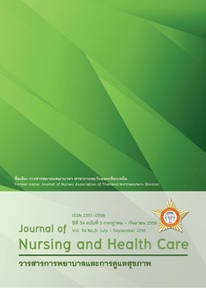ปัจจัยที่มีความสัมพันธ์กับการเกิดภาวะตัวเหลืองในทารกที่คลอดในโรงพยาบาลหนองสองห้องFactors Associated Neonatal Jaundice among Newborns in Nong Song Hong Hospital
คำสำคัญ:
ภาวะตัวเหลืองในทารกแรกเกิด อาการเหลืองจากสรีรวิทยา การส่องไฟรักษา ค่า Hematocrit neonatal jaundice, hyperbilirubinemia, phototherapy, hematocritบทคัดย่อ
บทคัดย่อ
ภาวะตัวเหลืองเป็นภาวะแทรกซ้อนที่พบได้บ่อยในทารกแรกเกิดซึ่งส่งผลให้พ่อแม่และครอบครัวมีความเครียด ความ
กังวลเกี่ยวกับอาการ รวมไปถึงการเปลี่ยนแปลงทางคลินิก ทำให้ทารกต้องอยู่โรงพยาบาลนานขึ้น ส่งผลให้ต้นทุนในการดูแลรักษาเพิ่มมากขึ้น หากทารกไม่ได้รับการวินิจฉัยหรือการรักษาที่ถูกต้อง อาจทำให้ทารกเกิดอาการชัก เกิดความพิการทางสมองหรือเกิดภาวะแทรกซ้อนรุนแรงจนถึงชีวิตได้ จากข้อมูลโรงพยาบาลหนองสองห้องในปี พ.ศ. 2552 พบภาวะตัวเหลืองในทารกแรกเกิดที่คลอดในโรงพยาบาล ร้อยละ 14 การวิจัยนี้จึงมีวัตถุประสงค์เพื่อศึกษาปัจจัยเชิงสาเหตุของภาวะตัวเหลืองในทารกแรกเกิด ณ โรงพยาบาลหนองสองห้อง โดยเก็บข้อมูลจากเวชระเบียน เลือกเฉพาะทารกเกิดมีชีพ ที่มีอายุตั้งแต่2 วันขึ้นไปและทารกที่คลอดขณะเดินทางมาโรงพยาบาลในระหว่างวันที่ 1 ตุลาคม พ.ศ. 2553 ถึง 30 มิถุนายน พ.ศ. 2556 จำแนกออกเปน็ 2 กลุม่ ไดแ้ กก่ ลุม่ ทารกปกติและกลุม่ ทารกที่มีอาการเหลืองจากสรีรวิทยาที่ไดรั้บการวินิจฉัยและสอ่ งไฟรักษาทั้งนี้ไม่นับรวมทารกที่คลอดออกมาพิการแต่กำเนิด ทารกที่มีภาวะหายใจลำบากรวมไปถึงกรณีที่มีการส่งต่อไปยังโรงพยาบาลศูนย์ขอนแก่นได้ข้อมูลทั้งสิ้น 1,108 คน จากนั้นทำการวิเคราะห์ข้อมูลโดยใช้สถิติทดสอบ Chi square test และ Fisher’s exact test เพื่อทดสอบหาปัจจัยที่ส่งผลต่อการเกิดภาวะตัวเหลืองในทารก ผลที่ได้จากการศึกษาพบว่าทารกที่คลอดก่อนถึงโรงพยาบาลเกิดภาวะตัวเหลืองมากที่สุดร้อยละ 40 โดยทารกที่คลอดก่อนถึงโรงพยาบาลเกิดภาวะตัวเหลืองในทารกแรกเกิด ร้อยละ 40 และพบว่าสถานที่คลอดมีความสัมพันธ์กับการเกิดภาวะตัวเหลืองในทารกแรกเกิดอย่างมีนัยสำคัญทางสถิติ (p-value = 0.034) และและสัดส่วนของมารดาที่มีค่า Hct ขณะตั้งครรภ์ตั้งแต่ 40% ขึ้นไปเกิดภาวะตัวเหลืองมากที่สุด ร้อยละ 19.7 โดย Hct ของมารดาขณะตั้งครรภ์มีความสัมพันธ์กับการเกิดภาวะตัวเหลืองในทารกแรกเกิด อย่างมีนัยสำคัญทางสถิติ (p-value = 0.029) ซึ่งผลการวิจัยครั้งนี้สามารถนำไปใช้ในการกำหนดเกณฑ์หรือแนวทางในการประเมินอาการทารก รวมไปถึงการเฝ้าระวังภาวะตัวเหลืองในระยะหลังคลอดได้
Abstract
Neonatal jaundice is a common complication found in newborns. It always causes stressful to parents and families and it also requires an addition clinical care. Consequently, newborns with this symptom need to stay in the hospital longer and hence the cost of clinical care will be definitely increased. Further, if the proper diagnosis or treatment is not treated, infants may severely convulse and may have aphasia disorder. It was observed that jaundice in newborns delivered to Nong Song Hong hospital was about 14%per year on average. This study aims to investigate the factor causing of hyperbilirubinemia in newborns at Nong Song Hong hospital. The data were collected from medical records during October 1, 2010 to June 30, 2013. The data set is classified into two groups:normal infants and infants with physiological hyperbilirubinemia which received the phototherapy treatment,
respectively. The infants born with congenital, respiratory distress syndrome, and the referred case to Khon Kaen hospital are excluded from the data set. A total of 1108 cases are analyzed using descriptive statistics, chi-square test, and Fisher’s exact test in order to determine the factors causing severe hyperbilirubinemia in infants. The results show that factors causing jaundice in newborns, at a significance level of 0.05, are the place of
labor and the concentration of hemoglobin (Hematocrit) during pregnancy. When consider place of labor, it was observed that the proportion of neonatal jaundice is about 40 percent in the case of giving birth before arriving in the hospital. This proportion is statistically higher than giving birth at the hospital (p-value = 0.034). The hematocrit (Hct) level during pregnancy larger than 40% has resulted in infants for hyperbilirubinemia around 19.7%. Mothers with Hct level during pregnancy from 40% or more tends to statistically affect more neonatal jaundice in newborns than the mothers with Hct level in the range of 33-39% and the range of < 33% (p-value = 0.029). The results of this study can be used to determine the criteria or guidelines to assess the newborns symptom including surveillance of neonatal jaundice after birth of the newborns.



